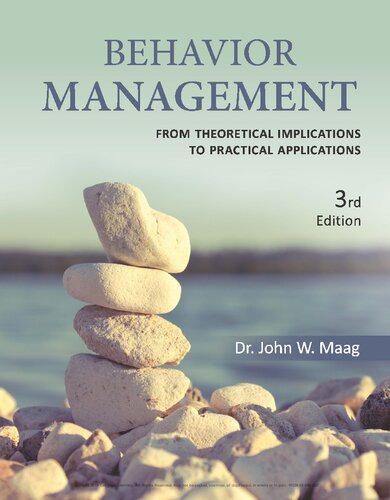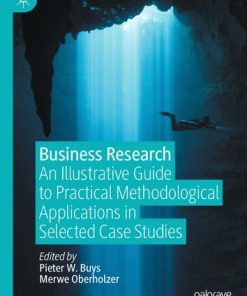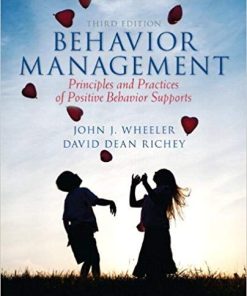Behavior Management From Theoretical Implications to Practical Applications 3rd Edition by John Maag 9798214338293
$50.00 Original price was: $50.00.$25.00Current price is: $25.00.
Behavior Management: From Theoretical Implications to Practical Applications 3rd Edition by John W. Maag – Ebook PDF Instant Download/DeliveryISBN: 9798214338293
Full download Behavior Management: From Theoretical Implications to Practical Applications 3rd Edition after payment.

Product details:
ISBN-13 : 9798214338293
Author : John W. Maag
Behavior management isn’t about providing students with stickers when they exhibit appropriate behaviors — it entails much more. Authored by nationally recognized scholar and behavioral consultant Dr. John W. Maag, this book focuses primarily on students’ observable behaviors and the environmental factors that affect their expression. As Maag points out, behavior management is probably one of the most misunderstood concepts in education. Written in an accessible style, this book demystifies stereotypical beliefs and misconceptions regarding the use of reinforcement, punishment, and self-control. Maag offers clear, yet detailed descriptions of proven intervention techniques, supplemented by step-by-step guidelines, real-life examples, sample forms, and visuals that assist you in implementing these techniques in the classroom. Although the techniques described are based on a sound theoretical and empirical foundation, the author limits the use of technical jargon.
Behavior Management: From Theoretical Implications to Practical Applications 3rd Table of contents:
Chapter 1. Introduction to Behavior Management
1-1. Behavior Modification
1-1a. Attributes of Behavior Modification
1-1b. Misconceptions About Behavior Modification
1-2. Defining Behavior
1-2a. Things That Are Not Behavior
1-2b. Problems Subjective Terms Present
1-2c. Considering Covert Behavior
1-3. Three-Term Contingency
1-3a. Antecedents
1-3b. Consequences
1-3c. A-B-C Analysis
1-4. Important Terms
1-5. Applied Behavior Analysis
1-6. Behavior Management and Its Relation to Schools
1-6a. School-Wide Positive Behavior Support
1-6b. Response to Intervention
1-7. Ethical Considerations in Behavior Management
1-8. Technology
1-9. Bringing It Together
Summary
Activities
Review Questions
References
Glossary
Chapter 2. Impediments to Managing Behavior
2-1. The Medical Model
2-1a. Why Differential Diagnosis Is Ineffective
2-1b. The Myth of Mental Illness
2-2. Students with Challenging Behaviors
2-3. Academic Versus Social Behavior and the Concept of Control
2-4. Personal Standards and Social Behavior
2-5. Contextual Variation
2-5a. Recognizing Context as a Determinant of Behavior
2-5b. Appreciating Context
2-5c. Facilitating Opportunities for Students to Interact
2-6. Cultural Diversity and Ethnicity
2-6a. Ethnic Minorities and Student Behavior
2-6b. Ethnic Minorities and Principles of Behavior
Summary
Activities
Review Questions
References
Glossary
Chapter 3. Theories of Behavior
3-1. Biophysical and Psychodynamic Explanations
3-1a. Biophysical Model
3-1b. Psychodynamic Theory
3-2. Behavioral Approaches
3-2a. Respondent (Classical) Conditioning
3-2b. Operant Conditioning
3-2c. Respondent Versus Operant Conditioning
3-3. Social Learning Theory
3-3a. Observational Learning and Performance
3-3b. Mechanisms of Observational Learning
3-3c. Cognitive Factors in Imitative Performance
3-3d. Implications of Social Learning Theory
3-4. The Ecological Model
3-4a. Basic Ecological Tenants
3-4b. Basic Tenants
3-4c. The Disturbing Environment
Summary
Activities
Review Questions
References
Glossary
Chapter 4. Basic Principles of Behavior
4-1. Principles Related to Increasing Behavior
4-1a. Positive Reinforcement
4-1b. Primary and Secondary (Conditioned) Reinforcers
4-1c. Negative Reinforcement (Escape Conditioning)
4-1d. Avoidance Conditioning
4-2. Schedules of Reinforcement
4-2a. Fixed-Ratio Schedule of Reinforcement
4-2b. Variable-Ratio Schedule of Reinforcement
4-2c. Fixed-Duration Schedule of Reinforcement
4-2d. Variable-Duration Schedule of Reinforcement
4-2e. Fixed-Interval Schedule of Reinforcement
4-2f. Variable-Interval Schedule of Reinforcement
4-2g. Interval Schedules with Limited Hold
4-3. Principles Related to Decreasing Behavior
4-3a. Application of Contingent Stimulation Punishment (Type I)
4-3b. Contingent Withdrawal of a Positive Reinforcer Punishment (Type II)
4-3c. Conditioned Punishment
4-3d. Extinction
4-3e. Forgetting
4-4. Stimulus Control and Related Terms
4-4a. Stimulus Control
4-4b. Stimulus Discrimination
4-4c. Stimulus Generalization
4-4d. Fading
4-5. Response Class and Related Terms
4-5a. Response Class
4-5b. Differential Reinforcement
4-5c. Response Differentiation
Summary
Activities
Review Questions
References
Glossary
Chapter 5. Counting and Recording Behavior
5-1. Reasons Why counting Behavior Is Important
5-1a. Precounting to Help Evaluate the Effectiveness of Intervention
5-1b. Counting to Identify the Correct Behavior
5-1c. Identifying Behavior Deserving of Intervention
5-1d. Evaluating Our Successes
5-2. Considerations Prior to Recording Behavior
5-3. Factors to Consider When Pinpointing a Target Behavior
5-3a. Stranger Test
5-3b. The So-What Test
5-3c. Fair Pair
5-3d. The Dead Man’s Test
5-4. Techniques for Recording Behavior
5-4a. Frequency (Event) Recording
5-4b. Duration Recording
5-4c. Direct Measurement of Permanent Products
5-4d. Interval Recording
5-4e. Time Sampling
5-5. Methods for Calculating Interobserver Reliability
5-5a. Frequency Recording and Interobserver Reliability
5-5b. Duration and Latency Recording and Interobserver Reliability
5-5c. Permanent Product and Interobserver Reliability
5-5d. Interval Interobserver Reliability
Summary
Activities
Review Questions
References
Glossary
Chapter 6. Graphing Behavior
6-1. Benefits of Graphing Behavioral Observations
6-2. Elements of a Graph
6-3. Collecting Baseline Data
6-4. Designs for Graphing Behavioral Observations
6-4a. The AB Design
6-4b. ABAB (Reversal or Withdrawal) Design
6-4c. Multiple Baseline Design
6-4d. Changing Criterion Design
6-4e. Changing Conditions Design
6-4f. Alternating Treatments Design
6-5. Constructing Graphs
Summary
Activities
Review Questions
References
Glossary
Chapter 7. Functional Behavioral Assessment (FBA)
7-1. An Overview of Functional Assessment
7-1a. Reasons for Conducting FBAs
7-1b. Basic Assumptions of Functional Assessment
7-1c. Types of Hypotheses
7-1d. General Approaches for Conducting Functional Assessment
7-2. Stages of Functional Assessment
7-2a. Stage I: Hypothesis Development
7-2b. Stage II: Hypothesis Testing
7-3. Writing Behavioral Intervention Plans
7-3a. Summary of the Findings
7-3b. General Approach
7-3c. Areas of Concern
7-3d. Monitoring and Evaluation
7-4. Issues in Functional Assessment
7-4a. Variability in FBA Practices
7-4b. Multiple Control and Transfer of Function
7-4c. Overruling Results of Functional Analysis
Summary
Activities
Review Questions
References
Glossary
Chapter 8. Preventative Approaches
8-1. Curricular Considerations
8-1a. The Curriculum as an Antecedent for Behavior Problems
8-1b. Types and Sequencing of Curricula
8-1c. Analyzing Content Knowledge
8-2. Direct Instruction
8-2a. Explain Goals and Objectives
8-2b. Sequence Content
8-2c. Review Prerequisite Skills
8-2d. Delivery of Information
8-2e. Give Clear Instructions, Explanations, and Relevant Examples
8-2f. Provide Guided Practice
8-2g. Check for Comprehension
8-2h. Provide Feedback
8-2i. Provide Independent Practice
8-2j. Conduct Formative Evaluation
8-3. Environmental Accommodations
8-3a. Arranging the Classroom Area
8-3b. Developing Classroom Rules
8-3c. Managing Transition Time
8-3d. Handling Classroom Materials
8-3e. Managing Students’ Paperwork
Summary
Activities
Review Questions
References
Glossary
Chapter 9. Reinforcement Techniques for Increasing Behavior
9-1. Catch Students Being Good
9-1a. Think Small
9-1b. “Gotcha Technique”
9-1c. The PEGS Program
9-2. Token Economies
9-2a. Reasons for the Effectiveness of Token Economies
9-2b. Procedures for Establishing a Token Economy
9-2c. Check-In Check-Out (CICO) Program
9-3. Behavioral Contracting
9-3a. Reasons Why Behavioral Contracts Work
9-3b. Components of a Behavioral Contract
9-3c. Guidelines for Successful Contracting
9-3d. The Contract Negotiation Process
9-3e. The Home–School Contract
9-4. Group-Oriented Contingencies
9-4a. Types of Group-Oriented Contingencies
9-4b. Ethical Considerations When Using Group-Oriented Contingencies
9-5. Novel Applications of Positive Reinforcement
9-5a. Mystery Motivators
9-5b. Chart Moves
9-5c. Spinners
9-5d. Raffles and Lotteries
9-5e. 100-Square Chart
9-5f. The Compliance Matrix
Summary
Activities
Review Questions
References
Glossary
Chapter 10. Differential Reinforcement for Decreasing Behavior
10-1. Types of Differential Reinforcement
10-1a. Differential Reinforcement of Incompatible and Alternative Behavior
10-1b. Differential Reinforcement of Other Behavior
10-1c. Differential Reinforcement of Low Rates of Behavior
10-2. Schedules of DRO and DRL
10-2a. Schedules of DRO
10-2b. Schedules of DRL
10-3. Considerations when Using Differential Reinforcement
Summary
Activities
Review Questions
References
Glossary
Chapter 11. Punishment
11-1. Undesirable Side Effects of Punishment
11-1a. Escape and Avoidance
11-1b. Emotional Reaction
11-1c. Aggression
11-1d. Response Substitution
11-1e. Response Facilitation
11-1f. Generalized Suppression
11-1g. Punishment Contrast
11-2. Limitations of Punishment
11-2a. Punishment Does Not Teach Appropriate Behaviors
11-2b. Punishment Does Not Eliminate Reinforcement
11-2c. Punishment Becomes Reinforcing
11-2d. Punishment May Affect Peers’ Behavior
11-2e. Punishment Should Be Intense
11-2f. Punishment Should Be Immediate
11-2g. Punishment Should Be Continuous
11-3. Types of Punishment
11-3a. Response Cost
11-3b. Time-Out
11-3c. Overcorrection
11-3d. Procedures Resembling Overcorrection
Summary
Activities
Review Questions
References
Glossary
Chapter 12. Teaching Self-Management
12-1. Theoretical Underpinnings of Self-Management
12-1a. Self-Control or Self-Management?
12-1b. The Operant Model of Self-Management
12-1c. The Cognitive Model of Self-Management
12-2. Self-Monitoring
12-2a. Self-Monitoring Attention
12-2b. Self-Monitoring Performance
12-2c. Specific Areas of Concern in Self-Monitoring
12-3. Self-Evaluation
12-3a. Developing a Rating System
12-3b. Setting a Daily Goal
12-4. Self-Reinforcement
12-4a. External Self-Reinforcement
12-4b. Internal Self-Reinforcement
Summary
Activities
Review Questions
References
Glossary
Chapter 13. Cognitive-Behavior Modification
13-1. An Overview of Cognitive-Behavior Modification
13-1a. The Cognitive A-B-C Model
13-1b. Factors Contributing to Cognitive-Behavior Modification
13-2. Methods of Cognitive-Behavioral Assessment
13-2a. Dangers Associated with Cognitive Assessment
13-2b. Cognitive Assessment Techniques
13-3. Cognitive-Behavior Modification Intervention Techniques
13-3a. Self-Instruction Training
13-3b. Attribution Retraining
13-3c. Thought Stopping
13-3d. Problem-Solving Training
13-3e. Cognitive Restructuring
Summary
Activities
Review Questions
References
Glossary
Chapter 14. Promoting Generalization
14-1. Overview of Generalization
14-1a. Types of Generalization
14-1b. Approaches to Generalization
14-1c. A Case Study in Generalization
14-2. Tactics for Promoting Generalization
14-2a. Taking Advantage of Natural Communities of Reinforcement
14-2b. Train Diversely
14-2c. Incorporating Functional Mediators
14-3. Steps for Implementing Generalization Tactics
14-3a. Step 1: List All Prerequisite Skills
14-3b. Step 2: List all Members of the Same Response Class
14-3c. Step 3: Define Stimulus Conditions
14-3d. Step 4: List Situations, Settings, and Places Target Behavior Is Performed
14-3e. Step 5: Selection and Sequencing of Teaching Examples
14-3f. Step 6: Identify Individuals Involved in Training
14-4. Issues in Promoting Generalization
14-4a. Attending to Stimulus Overselectivity
14-4b. Generalizing Teacher Repertoire
14-4c. Using Functional Contingencies
14-4d. Providing Sufficient Detail
14-4e. Conducting Outcome Assessment
People also search for Behavior Management: From Theoretical Implications to Practical Applications 3rd:
theoretical implication example
what is theoretical implication in research
implications of scientific management theory in education
empirical implications of theoretical models
behavior management theories
Tags: Behavior Management, Theoretical, Implications, Practical Applications, John Maag
You may also like…
dictionaries & phrasebooks
Uncategorized
Medicine - Dentistry
Wright’s Behavior Management in Dentistry for Children 3rd Edition Ari Kupietzky
Technique - Automation
Medicine & Health Science
Stress Management and Prevention: Applications to Daily Life 3rd Edition – Ebook PDF Version
Uncategorized












